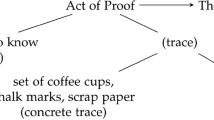Abstract
In mathematical research, the purpose of proof is to convince. The test of whether something is a proof is whether it convinces qualified judges. In the classroom, on the other hand, the purpose of proof is to explain. Enlightened use of proofs in the mathematics classroom aims to stimulate the students' understanding, not to meet abstract standards of “rigor” or “honesty.”
Similar content being viewed by others
References
Bishop, E.: 1972,Aspects of Constructivism, New Mexico State University, Mathematical Sciences, Las Cruces, N.M.
Davis, P. J.: 1977, ‘Proof, completeness, transcendentals, and sampling’,Journal of the Association for Computing Machinery 24, 298–310.
Davis, P. J. and Hersh, R.: 1981,The Mathematical Experience, Boston, Birkhauser.
de Villiers, M.: 1990, ‘The role and function of proof in mathematics’,Pythagoras 24, 17–24.
de Villiers, M.: 1991, ‘Pupils' needs for conviction and explanation within the context of geometry’,Pythagoras 26, 18–27.
Gale, D.: 1991, ‘Proof as explanation’,The Mathematical Intelligencer 12, 4.
Gleick, J.: 1987,Chaos, Penguin Books.
Halmos, P.: 1990, Address to 75th annual summer meeting of the Mathematical Association of America, Columbus, Ohio. (Tape recording).
Hanna, G.: 1983,Rigorous Proof in Mathematics Education, Toronto, OISE Press.
Hanna, G.: 1990, ‘Some pedagogical aspects of proof’,Interchange 21, 6–13.
Hardy, G. H.: 1929, ‘Mathematical proof’,Mind, XXXVIII,149, 1–25.
Hardy, G. H.: 1967,A Mathematician's Apology, Cambridge University Press.
Hungerford, T. W.: 1990,Abstract Algebra: An Introduction, Saunders College Publishing.
Knuth, D. E.: 1976, ‘Mathematics and computer science: Coping with finiteness’,Science 194, 1235–1242.
Lakatos, I.: 1976,Proofs and Refutations, Cambridge University Press.
Leron, U.: 1983, ‘Structuring mathematical proofs’,American Mathematical Monthly 90, 174–185.
Meyer, A. R.: 1974, ‘The inherent computational complexity of theories of ordered sets’,Proceedings of the International Congress of Mathematicians 1972 2, 481.
Miller, G. L.: 1976, ‘Riemann's hypothesis and tests for primality’,J. Comput. Syst. Sci. 13, 300–317.
Rabin, M. O.: 1976, ‘Probabilistic algorithms’, in J. F. Traub (ed.),Algorithms and Complexity: New Directions and Recent Results, New York, Academic Press.
Renz, P.: 1982, ‘Mathematical proof: What it is and what it ought to be’,The Two-Year College Mathematics Journal 12, 83–103.
Schwartz, J. T.: 1980, ‘Fast probabilistic algorithms for verification of polynomial identities’,Journal of the Association for Computing Machinery 27, 701–717.
Swart, E. R.: 1980, ‘The philosophical implications of the four-color theorem’,The American Mathematical Monthly 87, 697–707.
Author information
Authors and Affiliations
Rights and permissions
About this article
Cite this article
Hersh, R. Proving is convincing and explaining. Educ Stud Math 24, 389–399 (1993). https://doi.org/10.1007/BF01273372
Issue Date:
DOI: https://doi.org/10.1007/BF01273372




